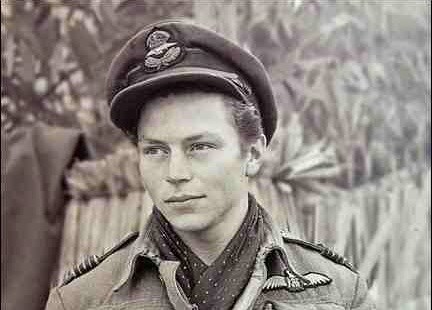Canada's greatest living fighter ace, 93-year-old Stocky Edwards, is a legend in aviation circles. But at heart, he's just a simple boy from Battleford.
I visited Stocky and his wife Toni last week at their lovely ocean-view home in Comox, B.C. He was more interested in talking about Battleford than his stellar wartime career. "I still get homesick for Saskatchewan sometimes," he confessed.
James Francis Edwards was born on June 5, 1921 in the farmhouse belonging to his grandparents near Nokomis. He was the second of six children. Ever since the war, he has gone by the nickname Stocky, meaning tough or plucky.
His parents moved to Battleford, where his father worked as an insurance agent. They were devout Roman Catholics and Stocky attended St. Vital Separate School.
That building is now the Fred Light Museum in Battleford. Stocky donated his uniform, a compass from a German fighter plane and an officer's mess kit to this excellent museum owned by the Town of Battleford. He then went on to high school at St. Thomas College.
Stocky learned to hunt from his father, and he was a crack shot. He was such a good hockey player his coaches spoke of the NHL. (Coincidentally, he was good friends with the Ballendine brothers from Battleford, all eight of whom served with the Canadian Army.)
Stocky earned money by delivering milk around town. "I knew every gopher hole, every house in Battleford. I could describe them all to this day," he said.
When he finished high school in June 1940, Stocky passed up a tryout with the Chicago Blackhawks and enlisted with the RCAF. That same year his maternal grandparents, who lived in London, were killed in a bombing raid. It made the young man even more determined to fly.
He received his wings in June 1941, trained in England and was posted to the African desert, where he flew a P-40 Kittyhawk, a single-engine fighter bomber. On his very first sortie, he shot down a Messerschmitt. (Most fighter pilots never shoot down a single aircraft).
Two years later, he was sent to Italy where he became a squadron leader and flew the lighter, faster Spitfire. He was posted back to England before the invasion. On D-Day, the day after his 23rd birthday, he flew his Spitfire over the beaches of Normandy.
After flying 350 sorties, Stocky was sent home for some well-deserved rest and had a happy reunion with his parents in Battleford. His brother Bernie was in the Canadian Army, his sister Jeanne in the Canadian Women's Army Corps and his sister Dorothy in the RCAF Women's Division.
In the spring of 1945, he returned to Europe and was made a wing commander of the 127 Wing, composed of four Canadian squadrons. In the last week before Germany surrendered, Stocky flew his 373rd and last mission over Kiel, Germany.
His "official" count in air-to-air combat was 18 aircraft destroyed, 16 damaged and seven probables, with another 14 destroyed on the ground. (An "ace" is someone who has shot down just five aircraft.)
To what does he owe his remarkable success? "I was an athlete before the war, " he said. "I lived a good life, I didn't smoke or drink . . . and I was religious. I said my prayers all the time, and I still do."
Most of all, though, he says his success was a matter of luck. "Another inch either way, and it could have been the other guy."
Stocky stayed in the RCAF. A year later, he married Norma Hatcher and they had two daughters, Dorothy and Jeanne. When the baby was four months old, Norma contracted polio and died. (Polio also crippled his sister Dorothy, who wore a brace on her leg until her death in 2004.)
A grief-stricken Stocky moved his young family from Quebec to Vancouver, where he reconnected with a young nurse named Alice Antonio (Toni). The two had met years earlier at a dance, where Stocky offended her by saying: "What a nice little armful!" But then the two lost touch.
Toni was from a small community called Hazel Dell outside Yorkton. She served in the RCAF Women's Division from 1942 to 1946, and then worked as a nurse until her wedding to Stocky on Feb. 3, 1951.
Stocky remained in the air force and achieved the rank of lieutenant colonel before retiring to Comox in 1972. He has received many awards including the Order of Canada in 2004. On July 18, he will be made a Knight of the French National Order of the Legion of Honour, presented for his actions on D-Day.
Two books have been written about him. In 1983 Michel Lavigne and Stocky published a book about his wartime experiences entitled Kittyhawk Pilot, printed by Turner-Warwick Printers in North Battleford. The other is a young adult book called The Desert Hawk, by Barbara Hehner, published in 2005.
I asked Stocky which awards he values the most. "The ones I received during the war," he said. They are the Distinguished Flying Cross and Bar, the Distinguished Flying Medal and the Canadian Forces Decoration.
Last year, he was inducted into the Canadian Aviation Hall of Fame. He also visited Gatineau, Que. and was taken for a ride in the P-40 Kittyhawk restored and dedicated to him by Vintage Wings of Canada.
Stocky and Toni had two more children - Debi (now called Angel) is a songwriter in Vancouver and Jim is a teacher in Victoria. Dorothy now lives in Ontario. Sadly, Jeanne died of breast cancer in 1998.
Stocky is also a talented artist. He didn't take up painting until after his retirement, and many of his lovely paintings feature the prairie landscape he still loves so much.



